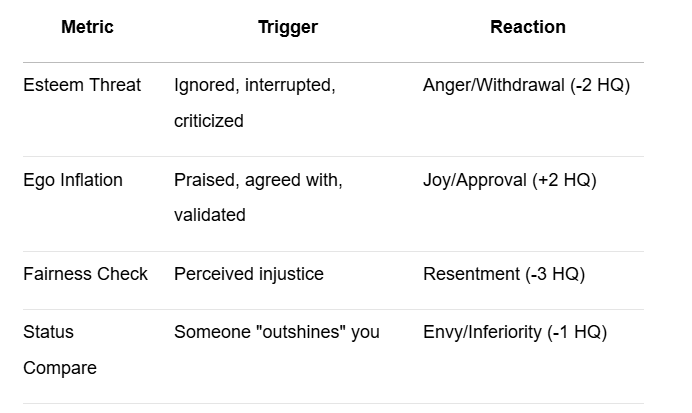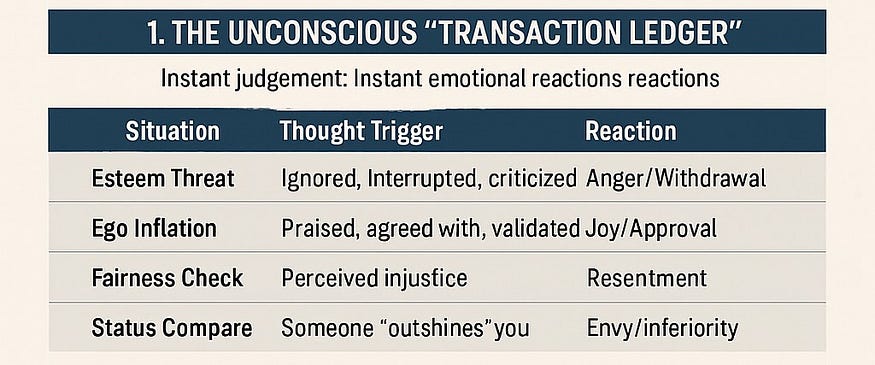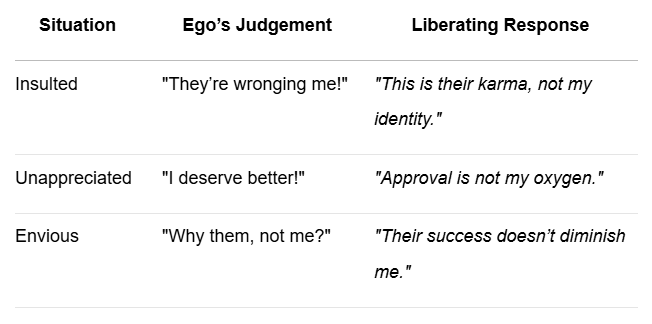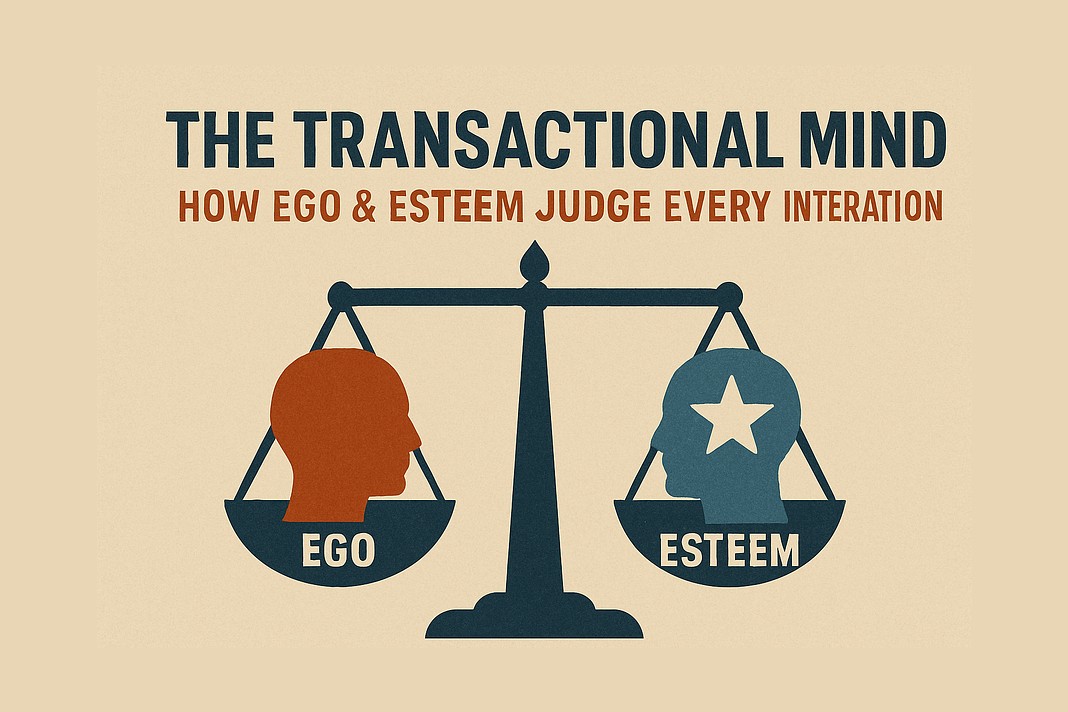(A Science-Vedanta Breakdown)
Your mind instantly evaluates every interaction — like a mental balance sheet tracking:
- Esteem Credits (Did they respect me?)
- Ego Debts (Did they insult me?)
- Karmic Interest (Past wounds amplifying present reactions)

Here’s how it works, with science-backed mechanics and Vedantic remedies.
1. The Unconscious “Transaction Ledger”
Your brain subconsciously scores interactions in real-time, triggering emotional reactions.
Key Judgement Parameters

Neuroscience Basis:
“The anterior cingulate cortex (ACC) acts as a ‘conflict detector,’ firing when social expectations are violated.” (Bush et al., Nature Neuroscience)
Vedantic Parallel:
“The ego (ahamkara) keeps accounts of pleasure/pain, binding you to suffering.” (Bhagavad Gita 2.62–63)

2. Why You Can’t “Just Let Go”
The mind replays transactions to protect self-image:
- Rumination Loop: Rehashing past slights (amygdala-hippocampus loop).
- Projection: Assuming others judge you as harshly as you judge them.
Science of Grudges:
“Holding onto anger activates the dorsal striatum, reinforcing victim identity.” (Ricciardi et al., Frontiers in Psychology)
Vedantic Insight:
“Like a parrot in a cage, the mind repeats old stories. Free yourself through witness consciousness (sakshi bhava).” (Ashtavakra Gita 15.1)
Vedantic Insight:
“Like a parrot in a cage, the mind repeats old stories. Free yourself through witness consciousness (sakshi bhava).” (Ashtavakra Gita 15.1)

3. Transaction Triggers in Real Life
Work Example:
- Transaction: Boss praises a colleague but not you.
- Ego Ledger: “My work is invisible. They’re favored!” (-3 HQ)
- Reaction: Silent resentment → Sabotage rumors.
Family Example:
- Transaction: Parent compares you to a sibling.
- Esteem Ledger: “I’m never enough.” (-4 HQ)
- Reaction: Defensive outburst → Cold war.
Social Example:
- Transaction: Friend forgets your birthday.
- Fairness Check: “After all I’ve done for them!” (-2 HQ)
- Reaction: Passive-aggressive meme posts.

4. How to Break the Cycle
A. Science-Backed Fixes
1. Cognitive Defusion:
- Label the emotion: “I’m having the thought that my boss disrespects me.”
2. Reappraisal:
- Ask: “Is this truly about me, or their own stress?”
B. Vedanta’s Radical Solution
1. Sakshi Bhava (Witness Mode):
- “I am not the ego keeping score. I am the awareness observing it.”
2. Nishkama Karma (Detached Action):
- “Do your duty, but drop the demand for recognition.” (Gita 2.47)
Transactional Mind Reset Cheat Sheet

Mantra for Instant Calm:
“I am not the mind that keeps score. I am the space where thoughts pass.”

Key Takeaways
- Your mind judges every interaction like a bank statement — but you’re not the accountant.
- HQ spikes when the ego feels shortchanged (esteem/status/fairness threats).
- Freedom comes from:
- Science: Interrupting the neural grudge loop.
- Vedanta: Realizing you’re the observer, not the transaction.
“The root of suffering is not the world, but your mental accounting of it.” — Buddha
Try this today: Next time you feel judged, ask:
“Who is the ‘I’ that feels offended?” (Hint: It’s just a thought.)
Step-by-Step Guide to Dissolve Transactional Thinking
(A Science & Vedanta Protocol)
Your mind’s “transaction ledger” is a habitual neural loop — but it can be rewired. Use this 7-step practice daily to break free.
Step 1: Pause the Reaction (Create Space)
Science: When triggered, your amygdala needs 6 seconds to pass the impulse to the prefrontal cortex.
Action:
- Physically freeze for 6 seconds (no words, no movement).
- Whisper: “This is a brain pattern, not reality.”
Vedanta Aid:
“Between stimulus and response, there is a gap. In that gap lies freedom.” — Viktor Frankl (echoing Patanjali’s Yoga Sutras)
Step 2: Label the Transaction
Science: Naming emotions reduces their intensity (Lieberman et al., Affect Labeling).
Action:
- Complete the sentence:
“My ego is registering a transaction of ______.” - Examples: “being disrespected,” “unfair comparison,” “status threat.”
Vedanta Insight:
“All suffering is a mislabelling (adhyasa) of the Self as the ego.” — Adi Shankara
Step 3: Audit the “Ledger”
Science: Writing down grudges decreases cortisol levels (Pennebaker’s Expressive Writing).
Action:
1. Draw a table:

2. Burn/shred the paper as a ritual of release.
Vedanta Ritual:
“Offer your mental accounts into the fire of wisdom (jnana agni).” — Taittiriya Upanishad
Step 4: Switch to Observer Mode
Neuroscience: Activating the posterior cingulate cortex (PCC) induces detachment.
Action:
- Close eyes and ask:
“Who is observing this emotion?”
“Is the ‘I’ feeling angry the same ‘I’ that breathes?”
Vedanta Mantra:
“I am not the thinker, but the awareness behind thought.” — Ramana Maharshi
Step 5: Apply Cognitive Reframing
Therapy Technique: Cognitive Behavioral Therapy (CBT) challenges distorted thoughts.
Action:
Replace the ego’s narrative with:
- “They wronged me” → “They acted from their own pain.”
- “I deserve better” → “My worth isn’t decided by others.”
Gita’s Wisdom:
“The wise see pain and pleasure as passing seasons.” (Bhagavad Gita 2.14)
Step 6: Practice Opposite Action
Neuroplasticity Hack: Acting against habitual reactions rewires the brain.
Action:
- If you want to avoid someone (HQ 8+), send them a neutral kindness (e.g., “Hope your day goes well”).
- If you crave validation, do self-praise instead.
Science Backing:
“Behavioral experiments dissolve neural fear circuits.” (Davidson, Neuroplasticity Research)
Vedanta Parallel:
“Do good to those who hate you — it liberates both.” (Yoga Vasistha)
Step 7: Install a Daily “Ledger Reset”
Habit Stacking: Pair with an existing routine (e.g., brushing teeth).
Action:
- Morning: Set intent: “Today, I am the sky — not the passing clouds.”
- Night: Review:
- “What transactions did I take personally?”
- “Were they truly about me?”
Vedanta Close:
“Burn the day’s accounts in the fire of awareness before sleep.” — Mandukya Upanishad
Why This Works
- Scientifically: Interrupts the default mode network (DMN) responsible for egoic rumination.
- Vedantically: Reveals the witness consciousness beyond transactions.
“Freedom is realizing you’re the screen, not the movie.” — Nisargadatta Maharaj
Commit to 21 days — the time needed to rewire neural pathways (neuroplasticity research).
📝 21-Day Transactional Mind Detox Tracker
(Print and use daily to rewire reactions) Click here
Day ____ of 21
1. Today’s Trigger:
- Person/Situation: ________________________
- Ego’s Transaction Label: ☐ Esteem Threat ☐ Status Compare ☐ Fairness Violation
2. Pause & Label (Steps 1–2)
- Physical Freeze Time: _____ seconds
- Emotion Named: ________________________
3. Ledger Audit (Step 3)

4. Observer Mode (Step 4)
- Mantra Used: “I am the ________, not the ________.”
5. Cognitive Reframe (Step 5)
- Old Thought: ________________________
- New Thought: ________________________
6. Opposite Action Taken (Step 6):
- ☐ Spoke kindly to “enemy”
☐ Did self-praise
☐ Other: ________
7. Nightly Reset (Step 7)
- Transactions Released: _____
- Sleep Intention: “I dissolve today’s accounts in awareness.”
Example Filled-Out Tracker
Day 4 of 21
- Trigger: Colleague took credit for my idea.
- Pause: Froze 8 sec, labeled “status threat.”
- Ledger Audit:
Ego: “She’s stealing my worth!”
Alternative: “She’s insecure about her own performance.” - Observer Mode: “I am the space, not the anger.”
- Opposite Action: Complimented her on another project.
- Nightly Reset: “I release needing credit to feel valued.”
Why 21 Days?
- Science: Minimum time to weaken amygdala hyperactivity (Neuropsychologia).
- Vedanta: 21 days represents 3 cycles of 7 (symbolizing completeness in Vedic rituals).
“You are not your thoughts; you are the awareness before thoughts.” — Eckhart Tolle
Stick this tracker on your mirror/fridge as a constant reminder.
– From Dr. Vis Desk
Did you subscribe to our daily Newsletter?
It’s Free Click here to Subscribe!
Source: Medium



















